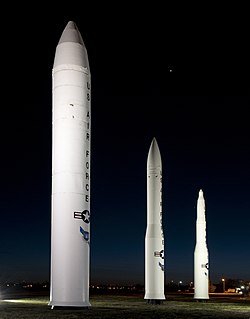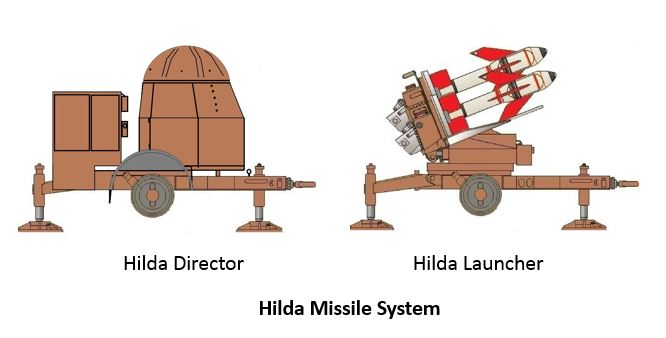
The Boeing CIM-10 BOMARC was a supersonic ramjet powered long-range surface-to-air missile (SAM) used during the Cold War for the air defense of North America. In addition to being the first operational long-range SAM and the first operational pulse doppler aviation radar, it was the only SAM deployed by the United States Air Force.

Rapier is a surface-to-air missile developed for the British Army to replace their towed Bofors 40/L70 anti-aircraft guns. The system is unusual as it uses a manual optical guidance system, sending guidance commands to the missile in flight over a radio link. This results in a high level of accuracy, therefore a large warhead is not required.
The SM-65 Atlas was the first operational intercontinental ballistic missile (ICBM) developed by the United States and the first member of the Atlas rocket family. It was built for the U.S. Air Force by the Convair Division of General Dynamics at an assembly plant located in Kearny Mesa, San Diego. Atlas became operational in October 1959, but was soon made obsolete as an ICBM by new development, and was retired from this role by 1965.

Beale Air Force Base (AFB) is a United States Air Force base located approximately 8 miles (13 km) east of Marysville, California. It is located outside of Linda, about 10 miles (16 km) east of the towns of Marysville and Yuba City and about 40 miles (64 km) north of Sacramento.

The South African Air Force (SAAF) is the air warfare branch of South African National Defence Force, with its headquarters in Pretoria. The South African Air Force was established on 1 February 1920. The Air Force has seen service in World War II and the Korean War. From 1966 the SAAF was involved in providing infantry support in a low intensity war in Angola, South-West Africa and Rhodesia. As the war progressed, the intensity of air operations increased until in the late 1980s, the SAAF were compelled to fly fighter missions against Angolan aircraft in order to maintain tactical air superiority. On conclusion of the Border War in 1990, aircraft numbers were severely reduced due to economic pressures as well as the cessation of hostilities with neighbouring states.

Seacat was a British short-range surface-to-air missile system intended to replace the ubiquitous Bofors 40 mm gun aboard warships of all sizes. It was the world's first operational shipboard point-defence missile system, and was designed so that the Bofors guns could be replaced with minimum modification to the recipient vessel and (originally) using existing fire-control systems. A mobile land-based version of the system was known as Tigercat.

McCoy AFB is a former U.S. Air Force installation located 10 miles (16 km) southeast of Orlando, Florida. It was a training base during World War II. From 1951 to 1975, it was a front line Strategic Air Command (SAC) base during the Cold War and Vietnam War. It was Orlando's biggest employer and economic backbone prior to the opening of Walt Disney World in 1971.

Tactical Air Command (TAC) is an inactive United States Air Force organization. It was a Major Command of the United States Air Force, established on 21 March 1946 and headquartered at Langley Air Force Base, Virginia. It was inactivated on 1 June 1992 and its personnel and equipment absorbed by Air Combat Command (ACC).

Aerospace Defense Command was a major command of the United States Air Force, responsible for continental air defense. It was activated in 1968 and disbanded in 1980. Its predecessor, Air Defense Command, was established in 1946, briefly inactivated in 1950, reactivated in 1951, and then redesignated Aerospace rather than Air in 1968. Its mission was to provide air defense of the Continental United States (CONUS). It directly controlled all active measures, and was tasked to coordinate all passive means of air defense.

The 44th Missile Wing is an inactive United States Air Force unit. Its last assignment was with Twentieth Air Force, being assigned to Ellsworth AFB, South Dakota. It was inactivated on 4 July 1994.

The Boeing EC-135 is a retired family of command and control aircraft derived from the Boeing C-135 Stratolifter. During the Cold War, the EC-135 was best known for being modified to perform the Looking Glass mission where one EC-135 was always airborne 24 hours a day to serve as flying command post for the Strategic Air Command in the event of nuclear war. Various other EC-135 aircraft sat on airborne and ground alert throughout the Cold War, with the last EC-135C being retired in 1998. The EC-135N variant served as the tracking aircraft for the Apollo program.

The United States Air Force's 9th Space Warning Squadron was a United States Air Force missile warning unit located at Robins AFB, Georgia.

The Emergency Rocket Communications System (ERCS) was designed to provide a reliable and survivable emergency communications method for the United States National Command Authority, using a UHF repeater placed atop a Blue Scout rocket or Minuteman II intercontinental ballistic missile. ERCS was deactivated as a communication means when President George H.W. Bush issued a message to stand down SIOP-committed bombers and Minuteman IIs on 27 September 1991. Headquarters SAC was given approval by the Joint Chiefs of Staff to deactivate the 494L payloads beginning 1 October 1992. However, Headquarters SAC believed it was inefficient and unnecessary to support ERCS past fiscal year 1991, and kept the accelerated deactivation schedule.
A missile combat crew (MCC), is a team of highly trained specialists, often called missileers, staffing Intermediate Range and Intercontinental ballistic missile systems. In the United States, men and women, officially coded as Nuclear and Missile Operations Officers, of the United States Air Force, operate underground missile systems at launch control centers located throughout the country. There are also a select few missileers that have the chance to become part of a Missile Combat Crew-Airborne (MCC-A) operating the Airborne Launch Control System which provides a survivable launch capability for the Minuteman ICBM force. Crew size varied among the different missile systems, but the number was always greater than one, to abide by USSTRATCOM's Two-man rule for positive control of nuclear weapons.

Project Emily was the deployment of American-built Thor intermediate-range ballistic missiles (IRBMs) in the United Kingdom between 1959 and 1963. Royal Air Force (RAF) Bomber Command operated 60 Thor missiles, dispersed to 20 RAF air stations, as part of the British nuclear deterrent.

Francis E. Warren Air Force Base is a United States Air Force (AFB) base located approximately 3 miles (4.8 km) west of Cheyenne, Wyoming. It is one of three strategic-missile bases in the U.S. It was named in honor of Francis E. Warren in 1930. Warren AFB is home of the 90th Missile Wing, assigned to the Twentieth Air Force, Air Force Global Strike Command. The 90 MW operates the LGM-30G Minuteman III ICBM. It is also the home of Twentieth Air Force, which commands all U.S. Air Force ICBMs.

120 Squadron SAAF was a South African Air Force squadron formed in 1970 to operate the South African/French Cactus surface-to-air missile systems in an air defence role. The unit was disbanded when the Cactus system was retired from service in the late 1980s.

122 Squadron SAAF was a South African Air Force squadron formed in 1970 to operate the South African/French Cactus surface-to-air missile systems in an air defence role. The unit was disbanded when the Cactus system was retired from service in the late 1980s.

Fleet Air Reconnaissance Squadron 4 (VQ-4), nicknamed the Shadows, is a naval aviation squadron of the United States Navy based at Tinker Air Force Base, Oklahoma. The squadron flies the Boeing E-6B Mercury airborne command post and communications relay aircraft. It is part of the U.S. Navy's TACAMO community, whose mission is to enable the President of the United States and the Secretary of Defense to directly communicate with U.S. submarines, bombers, and missile silos during a nuclear war.



















